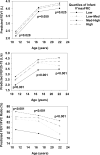Poor airway function in early infancy and lung function by age 22 years: a non-selective longitudinal cohort study
- PMID: 17765525
- PMCID: PMC2831283
- DOI: 10.1016/S0140-6736(07)61379-8
Poor airway function in early infancy and lung function by age 22 years: a non-selective longitudinal cohort study
Abstract
Background: Together with smoking, the lung function attained in early adulthood is one of the strongest predictors of chronic obstructive pulmonary disease. We aimed to investigate whether lung function in early adulthood is, in turn, affected by airway function measured shortly after birth.
Methods: Non-selected infants were enrolled at birth in the Tucson Children's Respiratory Study between 1980 and 1984. We measured maximal expiratory flows at functional residual capacity (Vmax(FRC)) in 169 of these infants by the chest compression technique at a mean of 2.3 months (SD 1.9). We also obtained measurements of lung function for 123 of these participants at least once at ages 11, 16, and 22 years. Indices were forced expiratory volume in 1 s (FEV1), forced vital capacity (FVC), and forced expiratory flow between 25% and 75% of FVC (FEF25-75), both before and after treatment with a bronchodilator (180 microg of albuterol).
Findings: Participants who had infant Vmax(FRC) in the lowest quartile also had lower values for the FEV1/FVC ratio (-5.2%, p<0.0001), FEF25-75 (-663 mL/s, p<0.0001), and FEV1 (-233 mL, p=0.001) up to age 22, after adjustment for height, weight, age, and sex, than those in the upper three quartiles combined. The magnitude and significance of this effect did not change after additional adjustment for wheeze, smoking, atopy, or parental asthma.
Interpretation: Poor airway function shortly after birth should be recognised as a risk factor for airflow obstruction in young adults. Prevention of chronic obstructive pulmonary disease might need to start in fetal life.
Figures

Comment in
-
Early lung development and COPD.Lancet. 2007 Sep 1;370(9589):717-9. doi: 10.1016/S0140-6736(07)61354-3. Lancet. 2007. PMID: 17765505 No abstract available.
References
-
- Burrows B, Knudson RJ, Lebowitz MD. The relationship of childhood respiratory illness to adult obstructive airway disease. Am Rev Respir Dis. 1977 May;115(5):751–60. - PubMed
-
- Samet JM, Tager IB, Speizer FE. The relationship between respiratory illness in childhood and chronic air-flow obstruction in adulthood. Am Rev Respir Dis. 1983 Apr;127(4):508–23. - PubMed
-
- Martinez FD, Morgan WJ, Wright AL, Holberg CJ, Taussig LM. Diminished lung function as a predisposing factor for wheezing respiratory illness in infants. N Engl J Med. 1988 Oct 27;319(17):1112–7. - PubMed
-
- Martinez FD, Wright AL, Taussig LM, Holberg CJ, Halonen M, Morgan WJ, The Group Health Medical Associates Asthma and wheezing in the first six years of life. N Engl J Med. 1995 Jan 19;332(3):133–8. - PubMed
-
- Tager IB, Hanrahan JP, Tosteson TD, Castile RG, Brown RW, Weiss ST, et al. Lung function, pre- and post-natal smoke exposure, and wheezing in the first year of life. Am Rev Respir Dis. 1993 Apr;147(4):811–7. - PubMed
Publication types
MeSH terms
Grants and funding
LinkOut - more resources
Full Text Sources
Other Literature Sources
Medical

